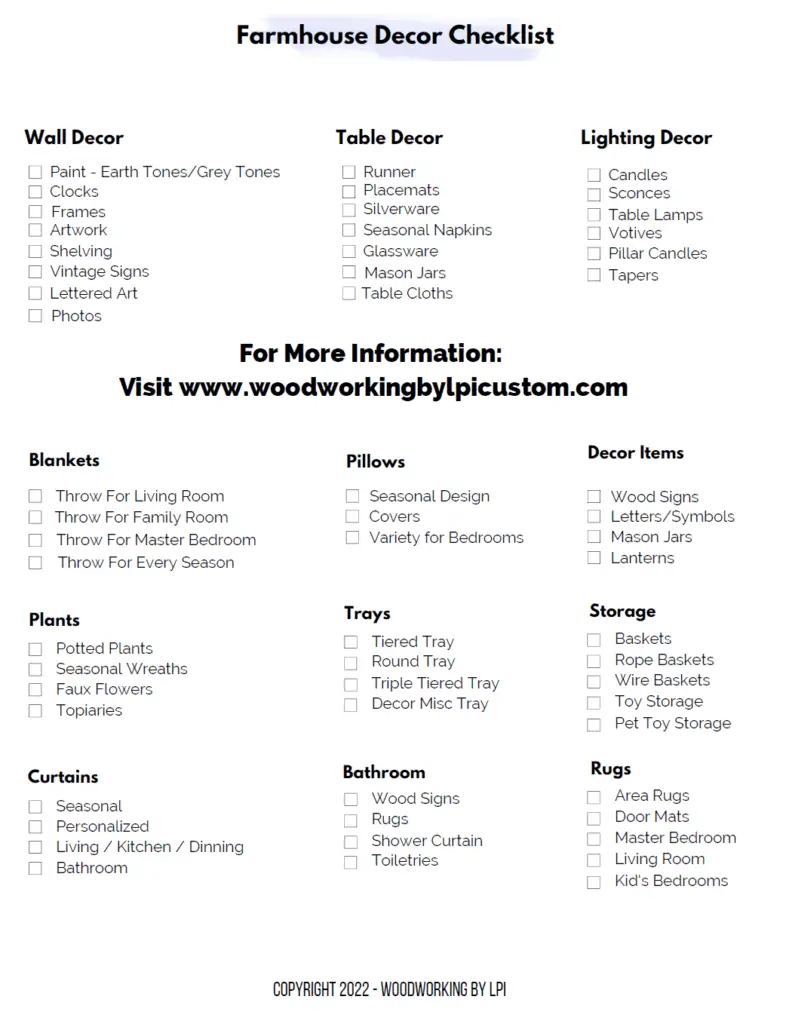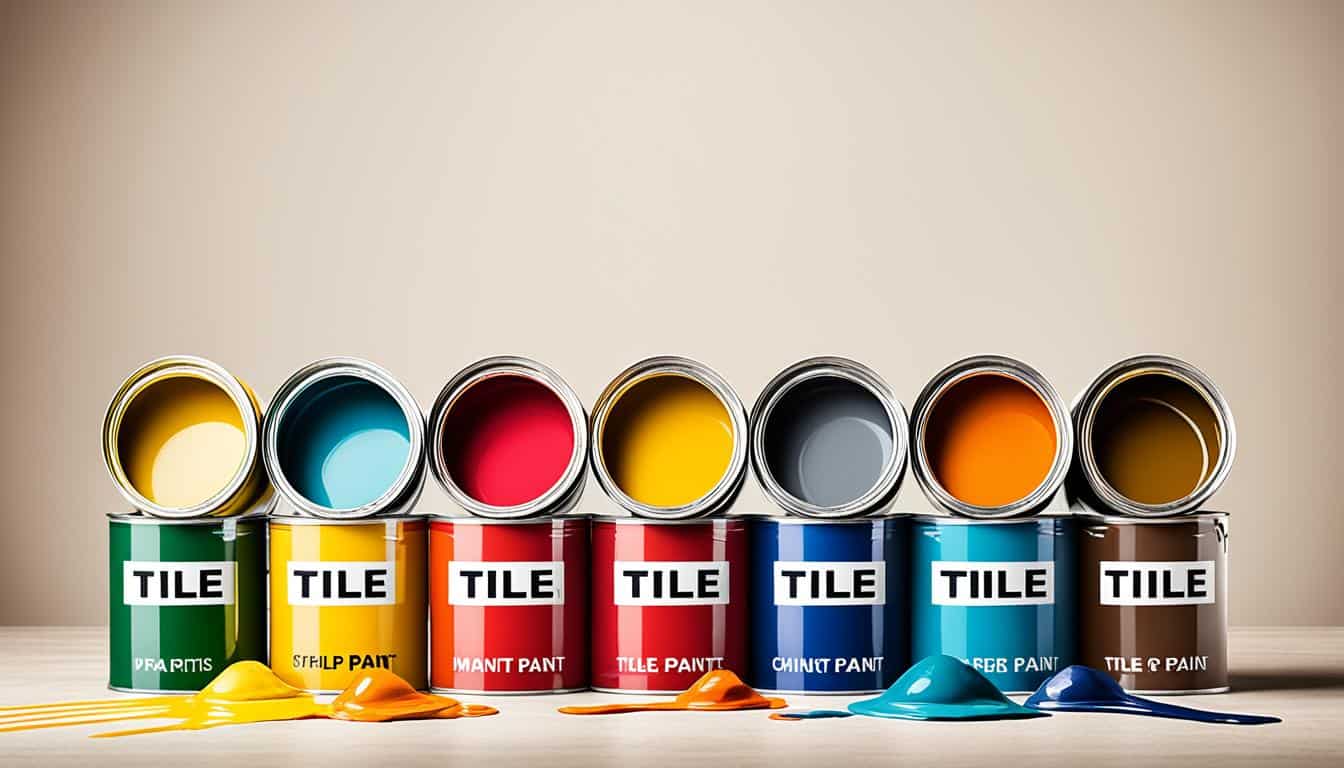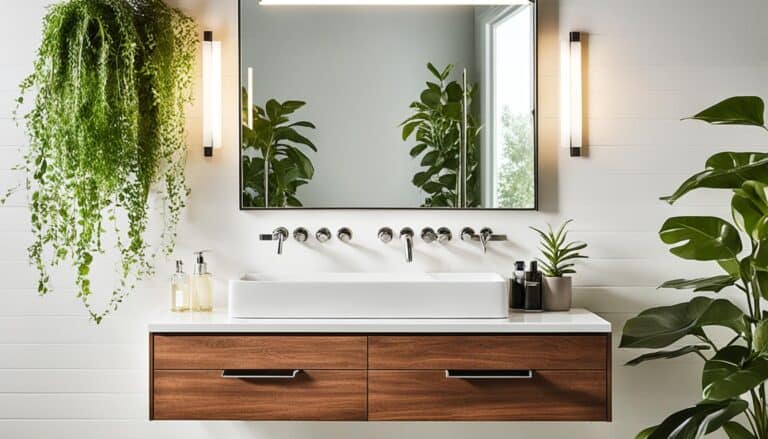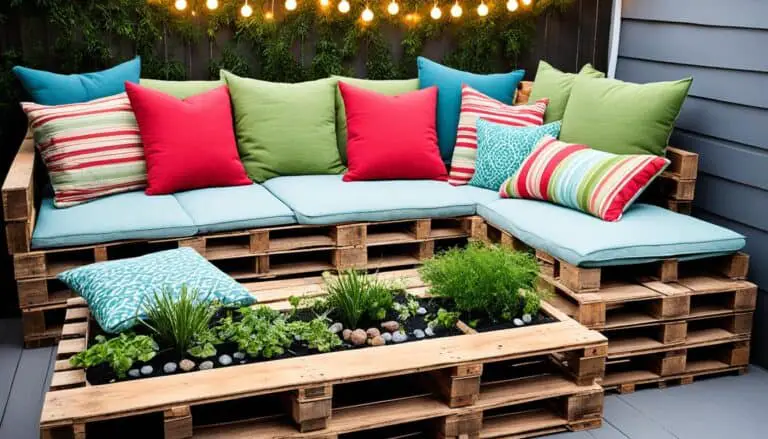Tired of your outdated floor tiles but don’t want to go through the hassle and expense of replacing them? We’ve got good news for you! Painting floor tiles can be a game-changer when it comes to refreshing your space. But, can you really paint floor tile? Let’s dive in and find out!
Understanding the Durability of Painted Floor Tile
When considering painting floor tiles, it’s important to understand the durability of the painted surface. To gain insight into this, let’s delve into a Rustoleum floor tile paint review that provides valuable information about the long-term performance of painted floor tiles.
The review focused on a painted tile floor located in a workshop, a high-traffic area that is exposed to various elements. After one year, the painted tile floor exhibited visible wear and tear, including small nicks, scratches, and chips. However, it’s worth noting that the extent of damage was more pronounced due to the intensive foot traffic and harsh conditions experienced in a workshop setting.
In contrast, in areas with lower foot traffic, the painted tile floor remained in good condition, with minimal chipping or scratching. This suggests that the durability of painted floor tile may be influenced by several factors:
- The type of paint used: Certain types of paint may offer better durability and resistance to wear and tear.
- The level of foot traffic: Higher foot traffic areas are more prone to accelerated wear and damage.
- The overall maintenance and cleaning of the surface: Regular cleaning and proper maintenance can help preserve the appearance and longevity of painted floor tiles.
By considering these factors, you can make informed decisions when planning to paint your floor tiles, ensuring that you choose the right paint and take appropriate measures to maximize the durability of the painted surface.
Steps for Painting Floor Tile
To successfully paint floor tile, proper preparation and application techniques are key. Follow these steps to achieve a professional-looking floor tile renovation:
- Clean the tile: Start by thoroughly cleaning the tile surface to remove any dirt, grime, or residue. Use a suitable cleaner and scrub the tiles using a scrub brush or sponge.
- Sand the surface: Lightly sand the tile surface to create a rough texture that will help the paint adhere. Use fine-grit sandpaper and sand in a circular motion to ensure even coverage. After sanding, wipe away any dust with a clean cloth.
- Repair cracks and missing grout: Inspect the tile for any cracks or missing grout and repair them using a suitable tile repair product or epoxy compound. Follow the product instructions for best results.
- Apply a bonding primer: Apply a bonding primer specifically designed for floor tile. Use a paintbrush or roller to apply an even coat of primer to the entire tile surface. Allow the primer to dry completely according to the manufacturer’s instructions.
- Paint the tile: Once the primer is fully dry, apply multiple coats of high-quality floor tile paint. Use a paintbrush or roller to achieve even coverage. Follow the manufacturer’s instructions for drying time between coats.
- Finish with a topcoat: Consider applying a topcoat or sealant to protect the painted surface and enhance its longevity. Follow the manufacturer’s instructions for application.
By following these steps, you can successfully paint your floor tiles and achieve a beautiful and lasting floor tile renovation.
Choosing the Right Paint for Floor Tiles
When it comes to giving your floor tiles a fresh new look, choosing the right paint is crucial. It’s important to select a product that is specifically formulated for painting floor tiles, as regular wall paint may not provide the durability and adhesion required. Two popular brands known for their quality floor tile paints are Benjamin Moore and Rustoleum. These paints are designed to withstand the wear and tear of foot traffic, ensuring a long-lasting and beautiful finish for your floor.
Benjamin Moore Floor and Patio Paint offers a wide range of colors to suit your style and preferences. With their high-quality formula, you can expect excellent coverage and resistance to chipping and scratching. Rustoleum Floor Tile paint is another reliable option, known for its durability and ability to transform tired, outdated floor tiles into a fresh and modern look.
Comparison of Benjamin Moore and Rustoleum Floor Tile Paints
| Brand | Features | Colors | Price Range |
|---|---|---|---|
| Benjamin Moore Floor and Patio Paint | Durable and resistant to chipping and scratching | Wide range of colors available | $30-$50 per gallon |
| Rustoleum Floor Tile paint | Long-lasting and easy to apply | Various colors to choose from | $20-$30 per quart |
Both options provide excellent coverage and are suitable for DIY enthusiasts looking to refresh their floor tiles. It’s important to consider the color options available and select one that complements your existing decor or desired aesthetic. Remember to follow the manufacturer’s instructions for application and drying time to ensure the best results.
With the right paint and proper application, you can transform your floor tiles and give your space a renewed and stylish look.
Pros and Cons of Painting Floor Tiles
Painting floor tiles offers several advantages when it comes to floor tile renovation and updating your space. However, it’s important to consider the limitations and potential drawbacks of this approach.
Pros of Painting Floor Tiles
- Cost-effective alternative: Painting floor tiles is a budget-friendly option compared to replacing the entire flooring. It allows you to achieve a refreshed look without breaking the bank, saving both time and money.
- Design flexibility: One of the main benefits of painting floor tiles is the wide range of design options it offers. You can choose from various colors and patterns to customize the look of your space, creating a unique and personalized design.
- Quick and easy update: Painting floor tiles is a relatively simple and straightforward DIY project. With proper preparation and techniques, you can transform the appearance of your space within a short period of time.
Cons of Painting Floor Tiles
- Durability concerns: While painted floor tiles can provide a temporary solution, they may not be as durable as real tiles. Over time, especially in high-traffic areas, painted tiles may be prone to chipping, scratching, or wearing off.
- Maintenance requirements: Painted floor tiles may require more frequent maintenance compared to other flooring options. Periodic touch-ups may be necessary to maintain the appearance and address any signs of wear or damage.
Overall, painting floor tiles can be a cost-effective and visually appealing option for floor tile renovation and updating your space. However, it’s important to consider the potential limitations and weigh them against your specific needs and preferences.
DIY Floor Tile Painting Tips
When it comes to painting floor tiles, following the right techniques is crucial to achieving the best results. Here are some essential tips to keep in mind:
1. Proper Preparation: Before you start painting, ensure that the floor tiles are clean from any dirt, grime, or residue. Thoroughly clean the surface with a mild soap and water solution to remove any contaminants that could affect the paint’s adhesion. Additionally, lightly sanding the tiles will create a rough texture, allowing the paint to adhere better.
2. Use the Right Paint and Primer: To ensure a durable finish, it’s important to use paint and primer specifically designed for floor tiles. These products are formulated to withstand foot traffic and provide optimal adherence. Look for floor tile paints that offer good coverage and are resistant to chipping and scratching.
3. Apply Multiple Coats: Applying multiple coats of paint will help create a more even and long-lasting finish. Follow the manufacturer’s instructions on drying time between coats to ensure proper adhesion and durability. This will also allow you to achieve the desired color intensity and coverage.
4. Consider a Topcoat or Sealant: Adding a topcoat or sealant can provide an extra layer of protection for your painted floor tiles. This will help guard against scratches, stains, and general wear and tear. Choose a product that is compatible with the paint you used and apply it according to the manufacturer’s instructions.
5. Allow Sufficient Drying Time: Proper drying time is essential to ensure that the paint cures and hardens properly. Avoid stepping on the freshly painted floor tiles until they are completely dry to prevent smudging or damaging the finish. Follow the recommended drying time specified by the manufacturer.
By following these DIY floor tile painting tips, you can achieve a professional-looking finish and extend the lifespan of your painted floor tiles. Remember to give your project the attention it deserves by properly preparing the surface, using the right products, and allowing sufficient drying time. With a little patience and careful execution, you can enjoy the refreshed look of your floor tiles for years to come.
Cost and Time Considerations
Updating the look of your floor tiles doesn’t have to break the bank or disrupt your daily life. Painting floor tiles offers a cost-effective and efficient solution for floor tile renovation. Let’s explore the financial and time considerations of this DIY project.
Cost of Floor Tile Renovation
The cost of a floor tile renovation project depends on various factors, such as the size of the area to be painted and the quality of materials. On average, you can expect to spend between $50 and $200 for paint and other necessary supplies.
| Cost Breakdown | Estimated Price Range |
|---|---|
| Paint | $20 – $50 per gallon |
| Primer | $10 – $30 per gallon |
| Painting Supplies | $20 – $50 |
Keep in mind that these figures are approximate and can vary based on your location and specific project requirements. But overall, painting floor tiles is a budget-friendly alternative to replacing the flooring entirely.
Time Investment
One of the advantages of painting floor tiles is that it can be completed within a relatively short timeframe. The exact duration will depend on the size and complexity of the project, but in general, you can typically finish painting floor tiles in a weekend or a few days.
The time investment includes the following steps:
- Preparation: Cleaning the floor, sanding, and repairing any imperfections. This may take a few hours.
- Priming: Applying a bonding primer designed for floor tiles. Allow time for the primer to dry according to the manufacturer’s instructions.
- Painting: Applying multiple coats of high-quality floor tile paint, with drying time between each coat. This process can take a day or two, depending on the recommended drying time.
- Finishing touches: Adding a topcoat or sealant for added protection and longevity. Allow sufficient drying time before using the floor.
By following these steps and dedicating a few days to the project, you can achieve a stunning floor tile renovation without major disruptions to your routine.
Image
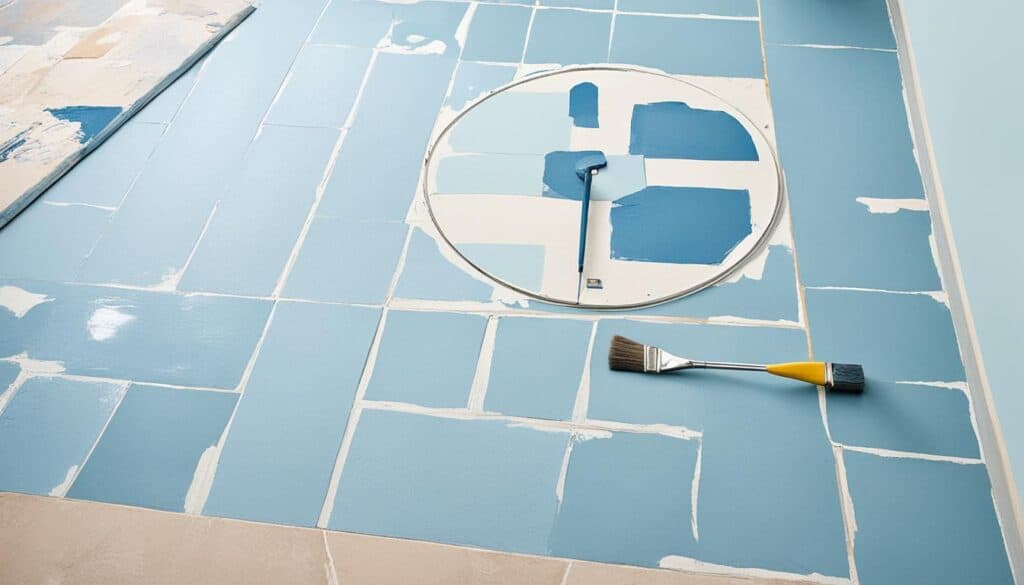
With a modest investment of both time and money, painting floor tiles allows you to update your space without significant inconvenience or financial strain. Now that we’ve explored the cost and time considerations, it’s time to discover the best paint options for your floor tile renovation project.
Maintaining Painted Floor Tiles
Proper maintenance is essential to ensure the longevity and continued attractiveness of your painted floor tiles. By following a few simple steps, you can keep your painted floors looking clean and fresh for years to come.
Regular Cleaning
To keep your painted floor tiles in pristine condition, regular cleaning is key. Use a mild soap and water solution to gently clean the surface, removing any dirt or debris. Avoid using abrasive cleaners or tools that may scratch or damage the painted finish.
Inspections and Touch-Ups
Periodically inspect your painted floor tiles for any signs of wear or damage. Check for areas where the paint may have chipped or scratched. If you notice any imperfections, touch up the affected areas using the same paint and techniques used for the initial painting process.
“By properly maintaining your painted floor tiles, you can extend their lifespan and continue to enjoy the refreshed look of your space.”
Protective Measures
To prevent unnecessary wear and tear, consider using protective measures on high-traffic areas. Place doormats or rugs in entryways or areas with heavy foot traffic to minimize the impact on your painted floor tiles.
Proper Handling
When moving furniture or heavy objects, take precautions to protect your painted floor tiles. Use furniture pads or felt protectors on the legs of chairs, tables, and other furniture to prevent scratches or dents.
Ongoing Maintenance
Keep an eye on your painted floor tiles and perform ongoing maintenance as needed. Regularly clean the surface, touch up any areas of damage, and take preventive measures to minimize wear and tear.
By following these maintenance tips, you can ensure that your painted floor tiles remain looking their best, providing a long-lasting and visually appealing renovation to your space.
Considering Alternatives to Painting Floor Tiles
While painting floor tiles can be a great option for a cost-effective and easy update, it’s important to consider other alternatives as well. If the condition of the existing floor tiles is beyond repair or if you’re looking for a more durable and long-lasting solution, replacing the tiles may be a better choice. Other alternatives to consider include installing new flooring materials such as vinyl, laminate, or engineered wood. Each option has its own advantages and considerations, so it’s important to carefully evaluate your specific needs and budget before making a decision.
If you’re considering an alternative to painting floor tiles, here are some key factors to keep in mind:
- Durability: Consider the longevity and resilience of the alternative flooring materials compared to painted tiles. Will they withstand the level of foot traffic and wear and tear in your space?
- Cost: Evaluate the cost of replacing the floor tiles with the alternative materials. Factor in the cost of materials, installation, and any additional expenses.
- Installation: Determine if you have the necessary skills and tools to install the alternative flooring materials yourself, or if you need to hire a professional.
- Design options: Explore the range of colors, patterns, and styles available for the alternative flooring materials. Consider how well they align with your desired aesthetic and overall design scheme.
By considering these factors, you can make an informed decision about the best alternative to painting floor tiles for your space. Whether you choose to replace the tiles or explore other flooring materials, it’s important to select a solution that meets your needs in terms of durability, cost, installation, and design.
Comparison of Flooring Materials
| Material | Advantages | Considerations |
|---|---|---|
| Vinyl | – Affordable – Wide range of styles and colors – Easy to clean and maintain | – Can be susceptible to scratches and dents – Can emit VOCs during installation |
| Laminate | – Budget-friendly – Resistant to scratches and fading – Easy to install | – Can be less durable than other materials – Susceptible to water damage if not properly sealed |
| Engineered Wood | – Natural wood appearance – Durability of hardwood – Can be installed in moisture-prone areas | – Higher cost compared to other materials – Requires professional installation – Prone to scratching and warping if not properly maintained |
Remember to evaluate each alternative flooring material based on your specific needs, preferences, and budget. Take into account the durability, cost, installation process, and design options. This will help you determine the best choice for updating your floor tiles and achieving the desired look and functionality in your space.
Exploring the Impact of a Floor Tile Makeover
A floor tile makeover can have a significant impact on the overall look and feel of your space. By painting floor tiles, you can completely transform the appearance of a room, making it feel brighter, more modern, or more cohesive with your desired design aesthetic. With a wide range of colors and patterns to choose from, you can create a customized look that suits your personal style and complements your existing decor. Whether you’re updating a bathroom, kitchen, or any other room with floor tiles, a makeover can breathe new life into the space and create a fresh and inviting atmosphere.
“A fresh coat of paint can make a dramatic difference. You can go from outdated to fabulous in just a few simple steps.”
Enhancing the Aesthetic Appeal
A floor tile makeover allows you to customize the look of your space and enhance its overall aesthetic appeal. Whether you prefer a clean and minimalist design or a bold and vibrant statement, painting your floor tiles gives you the freedom to express your creativity and achieve the desired look. You can choose colors that complement your existing color scheme or opt for contrasting shades to create a striking visual impact.
Creating a Cohesive Look
Painting your floor tiles can also help create a cohesive look throughout your home. By using the same color or pattern on your floor tiles, you can tie different spaces together, creating a seamless flow from one room to another. This can help create a sense of unity and harmony in your home, enhancing the overall visual appeal.
Transforming the Atmosphere
The impact of a floor tile makeover goes beyond purely aesthetic considerations. By updating your floor tiles, you can change the entire atmosphere of a room. Lighter colors can make a space feel more open and bright, while darker shades can create a cozy and intimate ambiance. Choosing the right color and finish can help you create the desired atmosphere that aligns with the function of the room.
Cost-Effective Solution
A floor tile makeover is a cost-effective solution compared to replacing the flooring entirely. Painting your floor tiles can save you a significant amount of money, as it eliminates the need for expensive materials, labor costs, and the inconvenience of a full-scale renovation. With just a few supplies and some DIY skills, you can achieve a fresh and updated look at a fraction of the cost.
“A floor tile makeover offers a budget-friendly way to transform your space and breathe new life into old, worn-out tiles.”
Endless Design Possibilities
Painting your floor tiles opens up a world of design possibilities. You can experiment with different colors, patterns, and even create intricate designs using stencils or painter’s tape. This allows you to customize your floor tiles to suit your personal style and create a truly unique look that reflects your individuality. Whether you prefer a classic and timeless design or a bold and contemporary statement, the options are endless.
Summary
In summary, a floor tile makeover can have a transformative effect on your space. By painting your floor tiles, you can enhance the overall aesthetic appeal, create a cohesive look, transform the atmosphere, and unleash your creativity through endless design possibilities. Not only is a floor tile makeover a cost-effective solution, but it also allows you to achieve a fresh and updated look without the hassle of a full renovation. So, if you’re looking to update your floor tiles and breathe new life into your space, consider the impact a floor tile makeover can have.
Exploring Different Floor Tile Painting Techniques
When it comes to DIY floor tile painting, there are various techniques you can use to achieve different effects and designs. These techniques allow you to unleash your creativity and create a unique floor tile design that suits your personal style. Let’s dive into some of the popular techniques:
1. Pattern and Stencil Painting
One popular technique is to create patterns or stencils using painter’s tape or pre-made stencils. This allows you to add visual interest to your floor tiles without the need to purchase new ones. You can create geometric shapes, intricate patterns, or even mimic the look of traditional patterned tiles. The possibilities are endless, and you can customize the design to fit the aesthetic of your space.
2. Ombre Painting
Ombre painting is a technique where you blend different shades of paint to create a gradient effect on your floor tiles. This can add depth and dimension to your space. You can choose a subtle ombre effect by using shades from the same color family, or you can opt for more dramatic contrasts for a bold statement. Experiment with different color combinations to achieve the desired look.
3. Mosaic-like Pattern
Another technique is to use multiple colors to create a mosaic-like pattern on your floor tiles. This technique is ideal for those who want to achieve a vibrant and eclectic look. You can choose complementary colors or create a random mix of colors for a playful and artistic effect. The key is to ensure a seamless transition between the different colors for a cohesive design.
No matter which technique you choose, remember to properly prepare the floor tiles by cleaning and sanding them before painting. Use high-quality floor tile paint and follow the manufacturer’s instructions for application and drying time. Applying a protective topcoat will help prolong the longevity of your painted floor tiles. Let your imagination run wild and transform your space with these DIY floor tile painting techniques!
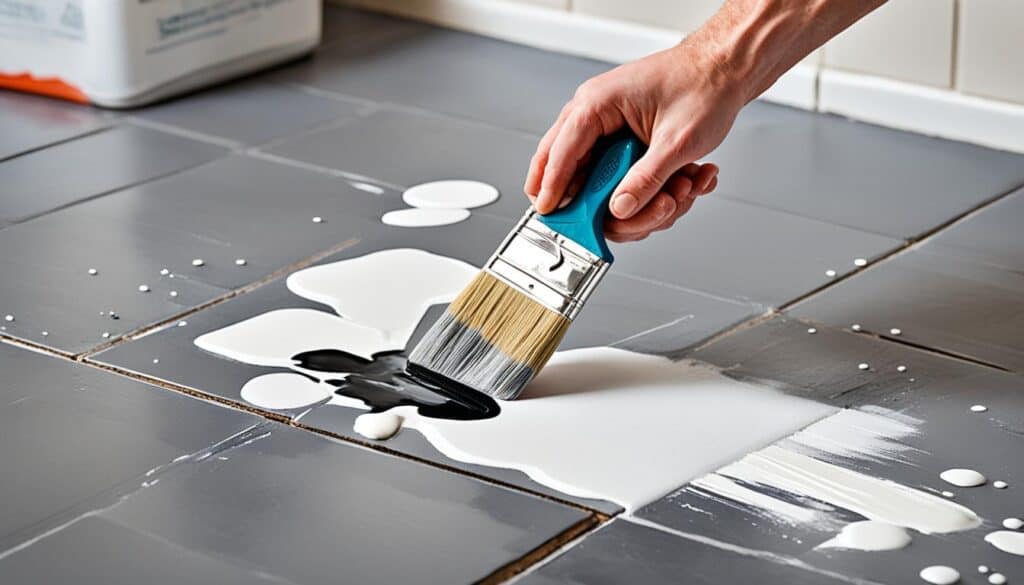
Assessing the Longevity of Painted Floor Tiles
The longevity of painted floor tiles can vary depending on several factors, including the type of paint used, the level of foot traffic, and the overall maintenance of the surface. While painted floor tiles may not last as long as real tiles or other flooring materials, they can still provide a durable and attractive solution for updating your space.
By following proper preparation and application techniques, choosing high-quality paint and primer, and maintaining the painted surface, you can extend the lifespan of your painted floor tiles and continue to enjoy their refreshed appearance for years to come.
Proper preparation is crucial when painting floor tiles. Start by thoroughly cleaning the tiles to remove any dirt, dust, or debris. This will ensure that the paint adheres properly to the surface. Next, sand the tiles lightly to create a rough texture that helps the paint bond better. Repair any cracks or damages in the tiles before applying the paint.
Choosing high-quality paint and primer designed specifically for floor tiles is essential for achieving a long-lasting finish. These products are formulated to withstand foot traffic and provide better durability compared to regular paints. Follow the manufacturer’s instructions for application and drying times to achieve the best results.
Maintaining the painted floor tiles is also important for their longevity. Avoid using abrasive cleaners or tools that can damage the paint. Regularly clean the tiles with a mild soap and water solution to keep them looking fresh. If any areas start to show signs of wear or damage, touch them up with additional paint to maintain a consistent appearance.
While painted floor tiles may not have the same lifespan as real tiles, they can still provide a cost-effective and attractive solution for floor tile renovation. With proper care and maintenance, painted floor tiles can add a touch of style and freshness to your space, allowing you to enjoy their renewed appearance for years to come.
The Impact of Painted Floor Tiles on Home Value
When considering floor tile renovation or any other home improvement project, it’s important to assess the potential impact on the value of your home. While updating floor tiles with a fresh coat of paint can enhance the aesthetic appeal of a space, it may not necessarily result in a significant increase in home value.
Factors such as the overall condition, functionality, and design cohesiveness of your home are more likely to have a greater impact on its value. However, a well-executed and visually appealing floor tile renovation can contribute to a positive impression and desirability of your home when potential buyers or renters view the property.
| Pros | Cons |
|---|---|
| Cost-effective alternative to replacing floor tiles | Painted floor tiles may be less durable than real tiles |
| Wide range of design options | Potential for chipping or scratching, especially in high traffic areas |
| Can transform the look of a room without a major renovation | May require periodic touch-ups and maintenance |
While updating your floor tiles can improve the overall appearance of your space, it’s essential to consider the long-term implications and weigh the pros and cons. Think about your specific needs, budget, and the preferences of potential future buyers or renters before deciding on a floor tile renovation project.
Conclusion
Painting floor tiles can be a cost-effective and easy way to refresh your space. Whether you’re looking to update your bathroom, kitchen, or any other room with floor tiles, painting offers a budget-friendly and customizable solution. While the durability of painted floor tiles may vary depending on factors such as paint quality and maintenance, it can provide a temporary solution for updating outdated or worn-out flooring.
By following proper preparation and application techniques, such as thorough cleaning, sanding, and using a bonding primer, you can achieve a refreshed and attractive look in your home. Choosing the right paint for floor tiles, like Benjamin Moore Floor and Patio Paint or Rustoleum Floor Tile Paint, is crucial for ensuring long-lasting results.
Before embarking on a DIY floor tile painting project, consider the pros and cons, explore different techniques, and evaluate your specific needs and desired outcome. While painted floor tiles may require more maintenance and periodic touch-ups, they offer a wide range of design options and can completely transform the appearance of a room. So, if you’re looking to update and personalize your space, why not give DIY floor tile painting a try?
FAQ
Can you paint floor tile?
Yes, you can paint floor tile. It is a cost-effective and easy way to refresh your space.
What are the steps for painting floor tile?
The steps for painting floor tile include cleaning the tile, sanding the surface, repairing any cracks or missing grout, applying a bonding primer, and multiple coats of high-quality floor tile paint.
What type of paint should I use for floor tiles?
It is important to use a paint specifically formulated for floor tiles. Examples include Benjamin Moore Floor and Patio Paint and Rustoleum Floor Tile paint.
What are the pros and cons of painting floor tiles?
The pros of painting floor tiles include cost-effectiveness and a wide range of design options. However, the cons include potential durability issues and the need for periodic maintenance and touch-ups.
What are some DIY floor tile painting tips?
Some DIY floor tile painting tips include proper preparation, using the right paint and primer, applying multiple coats, and considering a topcoat or sealant for added protection.
How much does it cost to paint floor tiles?
The cost of painting floor tiles can range from to 0, depending on the size of the area to be painted.
How long does it take to paint floor tiles?
The process of painting floor tiles can usually be completed within a weekend or a few days, depending on the size and complexity of the project.
How do I maintain painted floor tiles?
Regular cleaning with a mild soap and water solution is usually sufficient to maintain painted floor tiles. Avoid using abrasive cleaners or tools that could damage the painted finish.
What are the alternatives to painting floor tiles?
Alternatives to painting floor tiles include replacing the tiles or installing new flooring materials such as vinyl, laminate, or engineered wood.
What is the impact of a floor tile makeover?
A floor tile makeover can significantly enhance the overall look and feel of a space, creating a fresh and inviting atmosphere.
What techniques can I use for painting floor tiles?
There are various techniques you can use, including creating patterns or stencils, ombre painting, or using multiple colors to create a mosaic-like pattern.
How long do painted floor tiles last?
The longevity of painted floor tiles can vary depending on factors such as the type of paint used, foot traffic, and maintenance. With proper care, they can provide a durable and attractive solution.
What is the impact of painted floor tiles on home value?
While a floor tile makeover can enhance the aesthetic appeal of a space, its impact on home value may be minimal compared to factors such as overall condition and design cohesiveness.
Can you paint floor tiles as a DIY project?
Yes, painting floor tiles can be a DIY project that offers a budget-friendly and customizable solution for updating your space.

